T1-U-IPEX Module Datasheet
Last Updated on : 2025-11-07 09:54:40download
T1-U-IPEX module is a Wi-Fi and Bluetooth Low Energy (LE) combo module developed by Tuya Smart. It is composed of a highly integrated radio-frequency identification (RFID) chip T1 and a few peripheral components. It can run in the station (STA) mode and access point (AP) mode as well as support connection over Bluetooth LE.
Overview
T1-U-IPEX has a built-in 32-bit MCU with a maximum running speed of 160 MHz, built-in 1 MB flash memory, and 288 KB RAM. The module supports cloud connectivity, and the MCU’s extended instructions for signal processing enable it to efficiently implement audio encoding and decoding. Various peripherals are available, such as PWM, UART, and SPI. Up to five channels of 32-bit PWM output make the chip ideal for high-quality LED control.
Features
- Built-in low-power 32-bit MCU that also acts as an application processor
- Clock rate of 160 MHz
- Operating voltage: 3.0V to 3.6V
- Peripherals: 5 PWM pins, 2 UARTs, and 1 SPI
- Wi-Fi connectivity
- IEEE 802.11b/g/n.
- Channels 1 to 14 at 2.4 GHz.
- Supports WEP, WPA/WPA2, WPA/WPA2 PSK (AES), and WPA3 security modes.
- The maximum output power is +17 dBm for 802.11b transmission.
- Supports STA, AP, and STA + AP combo working modes.
- Two pairing modes are supported, namely bluetooth mode and access point (AP) mode. Both modes are available on Android and iOS devices.
- Operating temperature: -40°C to 105°C.
- Bluetooth connectivity
- Bluetooth Core Specification v5.2
- The transmitter power in Bluetooth mode is 6 dBm.
- Integral Wi-Fi and Bluetooth coexistence interface.
Applications
- Smart building
- Smart home and electrical appliance
- Smart socket and light
- Industrial wireless control
- Baby monitor
- IP camera
- Smart bus
Module interfaces
Dimensions and packaging
The T1-U-IPEX dimensions are 15.8±0.35 mm (W) × 20.3±0.35 mm (L) × 2.5±0.15 mm (H). The following figure shows the dimensions and packaging design of the T1-U-IPEX module.
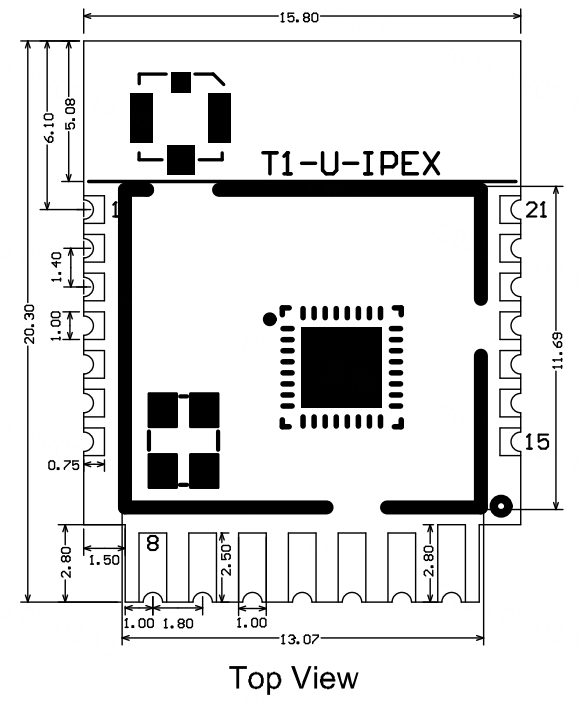
Pin definition
| Pin No. | Symbol | I/O type | Feature |
|---|---|---|---|
| 1 | P14 | I/O | A normal GPIO pin, corresponding to Pin 19 on the IC. It can be reused as SPI_SCK. |
| 2 | P16 | I/O | A normal GPIO pin, corresponding to Pin 20 on the IC. It can be reused as SPI_MOSI. |
| 3 | P23 | I/O | A normal GPIO pin, corresponding to Pin 16 on the IC. |
| 4 | P22 | I/O | A normal GPIO pin, corresponding to Pin 15 on the IC. |
| 5 | ADC | I/O | An ADC pin, corresponding to P20 (Pin 13) on the IC. |
| 6 | RX2 | I/O | UART_RX2, corresponding to P1 (Pin 30) on the IC. |
| 7 | TX2 | I/O | UART_TX2 to print logs, corresponding to P0 (Pin 31) on the IC. |
| 8 | P24 | I/O | Support hardware PWM4, corresponding to Pin 17 on the IC. |
| 9 | P9 | I/O | Support hardware PWM3, corresponding to Pin 27 on the IC. |
| 10 | P26 | I/O | Support hardware PWM5, corresponding to Pin 23 on the IC. |
| 11 | P6 | I/O | Support hardware PWM0, corresponding to Pin 24 on the IC. |
| 12 | P8 | I/O | Support hardware PWM2, corresponding to Pin 26 on the IC. |
| 13 | GND | P | Ground pin. |
| 14 | 3V3 | P | 3.3V power pin. |
| 15 | TX1 | I/O | UART_TX1 to send user data, corresponding to P11 on the IC (corresponding to Pin 29 on the IC). For more information about MCU general integration, see Hardware Design of CBx Module. |
| 16 | RX1 | I/O | UART_RX1 to receive user data, corresponding to P10 on the IC (corresponding to Pin 28 on the IC). For more information about MCU general integration, see Hardware Design of CBx Module. |
| 17 | P28 | I/O | A normal GPIO pin, corresponding to Pin 12 on the IC. |
| 18 | CEN | I/O | The reset pin, active low, and pulled up internally. It is compatible with the designs of other modules. Corresponding to Pin 11 on the IC. |
| 19 | P21 | I/O | A normal GPIO pin, corresponding to Pin 14 on the IC. |
| 20 | P17 | I/O | A normal GPIO pin, corresponding to Pin 22 on the IC. It can be reused as SPI_MISO. |
| 21 | P15 | I/O | A normal GPIO pin, corresponding to Pin 21 on the IC. It can be reused as SPI_CS. |
- The maximum input level of the ADC port is VBAT (typical supply voltage is 3.3 V). It is recommended to use MΩ level external voltage divider resistors and place a 100 nF ground filter capacitor close to the ADC port.
Pindicates the power pin, and I/O indicates the input and output pin.- For more information about MCU general integration, see Hardware Design of CBx Module.
Electrical parameters
Absolute electrical parameters
| Parameter | Description | Min value | Max value | Unit |
|---|---|---|---|---|
| Ts | Storage temperature | -55 | 125 | °C |
| VBAT | Supply voltage | -0.3 | 3.6 | V |
| Electrostatic discharge voltage (human body model) | TAMB -25°C | -4 | 4 | kV |
| Electrostatic discharge voltage (machine model) | TAMB -25°C | -200 | 200 | V |
Working conditions
| Parameter | Description | Min value | Typical value | Max value | Unit |
|---|---|---|---|---|---|
| Ta | Operating temperature | -40 | N/A | 105 | °C |
| VBAT | Supply voltage | 3 | 3.3 | 3.6 | V |
| VOL | I/O low-level input | VSS | N/A | VSS + 0.3 | V |
| VOH | I/O high-level output | VBAT − 0.3 | - | VBAT | V |
| Imax | I/O drive current | - | 6 | 20 | mA |
Radio frequency (RF) power
| Working status | Mode | Rate | Transmit/Receive power | Average value | Peak (Typical) value | Unit |
|---|---|---|---|---|---|---|
| Transmit | 11b | 11 Mbit/s | +17 dBm | 310 | 380 | mA |
| Transmit | 11g | 54 Mbit/s | +15 dBm | 280 | 344 | mA |
| Transmit | 11n | MCS7 | +14 dBm | 268 | 332 | mA |
| Receive | 11b | 11 Mbit/s | Continuous reception | 17 | 25 | mA |
| Receive | 11g | 54 Mbit/s | Continuous reception | 17 | 25 | mA |
| Receive | 11n | MCS7 | Continuous reception | 17 | 25 | mA |
Radio frequency fixed-frequency strong transmission mode, with a duty cycle of 99%.
Operating current
| Working mode | Status (Ta = 25°C) | Average value | Peak (Typical) value | Unit |
|---|---|---|---|---|
| Quick pairing (Bluetooth) | The module is pairing over Bluetooth. The Wi-Fi network status indicator blinks slowly. | 80 | 360 | mA |
| Quick pairing (AP) | The module is in AP mode. The Wi-Fi network status indicator blinks slowly. | 85 | 360 | mA |
| Connected | The module is connected to the cloud. The Wi-Fi network status indicator is steady on. | 90 | 330 | mA |
| Weakly connected | The connection between the module and the hotspot is intermittent. The Wi-Fi network status indicator is steady on. | 190 | 380 | mA |
| Disconnected | The module is disconnected from the cloud. The Wi-Fi network status indicator is steady off. | 67 | 380 | mA |
| Module disabled | The module’s clock enable (CEN) pin is pulled down. | 330 | N/A | μA |
The above data module is powered by a 3.3 V regulated power supply with firmware v6.0.0. There are slight differences in test data under different test environment conditions.
RF parameters
Basic RF features
| Parameter | Description |
|---|---|
| Operating frequency | 2.412 to 2.484 GHz |
| Wi-Fi standard | IEEE 802.11b/g/n (channels 1–14) |
| Data transmission rate |
|
| Antenna type | IPEX external antenna |
Wi-Fi transmitter (TX) performance
| Parameter | Min value | Typical value | Max value | Unit |
|---|---|---|---|---|
| RF average output power, 802.11b CCK mode, 11M | - | 17 | - | dBm |
| RF average output power, 802.11g OFDM mode, 54M | - | 15 | - | dBm |
| RF average output power, 802.11n OFDM mode, MCS7 (HT20) | - | 14 | - | dBm |
| Frequency error | -20 | - | 20 | ppm |
Wi-Fi receiver (RX) performance
| Parameter | Min value | Typical value | Max value | Unit |
|---|---|---|---|---|
| PER < 8%, RX sensitivity, 802.11b DSSS mode, 11M | - | -88 | - | dBm |
| PER < 10%, RX sensitivity, 802.11g OFDM mode, 54M | - | -75 | - | dBm |
| PER < 10%, RX sensitivity, 802.11n OFDM mode, MCS7 (HT20) | - | -73 | - | dBm |
| PER < 10%, RX sensitivity, Bluetooth, 1M | - | -96 | - | dBm |
Bluetooth transmitter (TX) performance
| Parameter | Min value | Typical value | Max value | Unit |
|---|---|---|---|---|
| Operating frequency | 2402 | - | 2480 | MHz |
| Transmission rate over the air | - | 1 | - | Mbit/s |
| Transmission power | -20 | 6 | 20 | dBm |
| Frequency error | -150 | - | 150 | KHz |
Bluetooth RX performance
| Parameter | Min value | Typical value | Max value | Unit |
|---|---|---|---|---|
| RX sensitivity | - | -96 | - | dBm |
| Max RF signal input | -10 | - | - | dBm |
| Intermodulation | - | - | -23 | dBm |
| Adjacent-channel rejection ratio | - | 10 | - | dB |
Antenna information
Antenna type
The T1-U-IPEX module uses an IPEX external antenna.
Antenna interference reduction
The distance between the antenna and other mental components should be at least 15 mm to provide the best Wi-Fi performance.
Packing and production instructions
Mechanical dimensions
Dimensions of the T1-U-IPEX PCB are 15.8±0.35 mm (W) × 20.3±0.35 mm (L) × 1.0±0.1 mm (H).
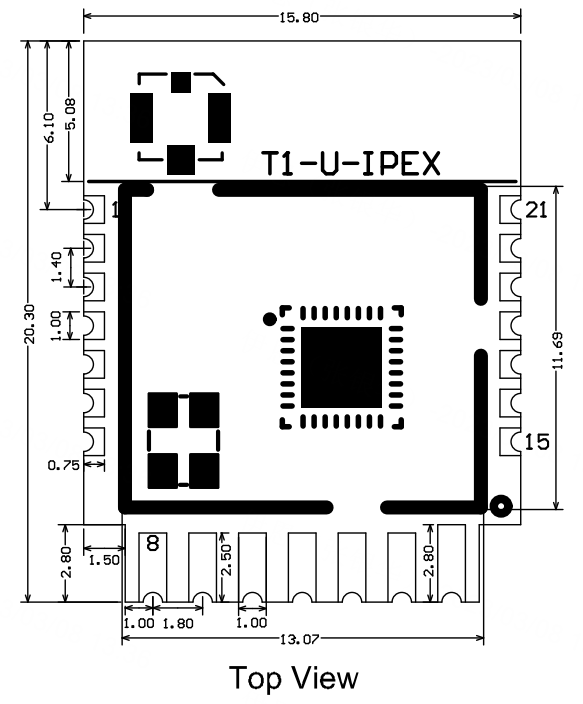
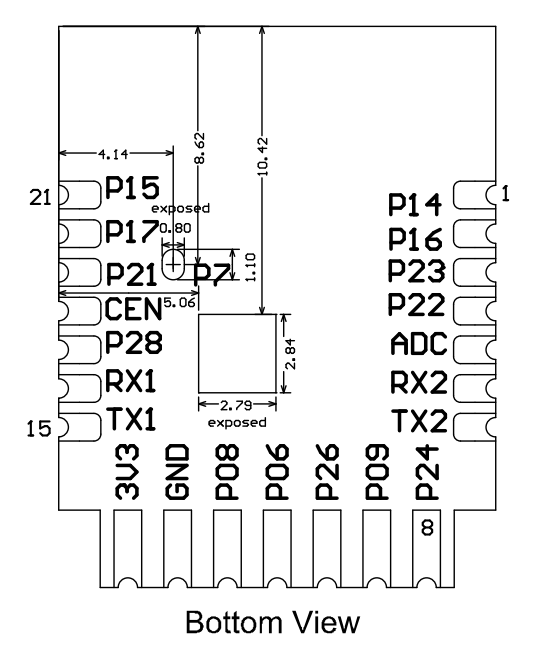
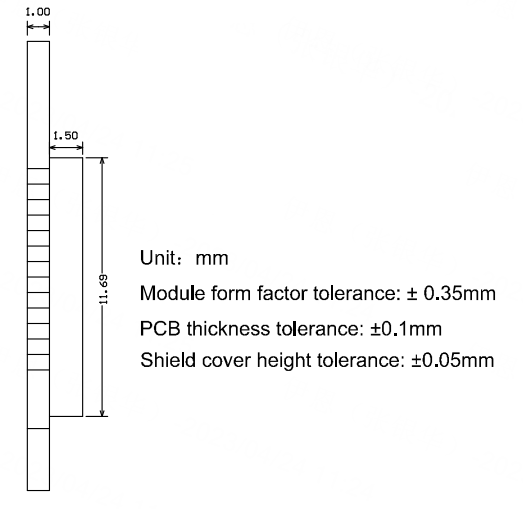
The following figure shows the recommended footprint of the T1-U-IPEX module.
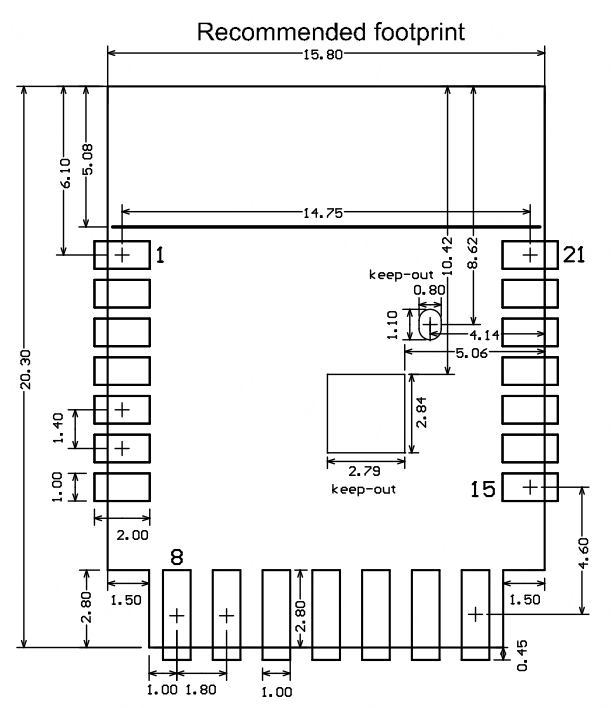
The area indicated as keep-out in the diagram above does not require tinning and should not have any traces routed through it.
Production instructions
-
For the modules that can be packaged with the surface-mount technology (SMT) or in in-line form, you can select either of them according to the PCB design solutions of customers. If a PCB is designed to be SMT-packaged, package the module with the SMT. If a PCB is designed to use an in-line package, use wave soldering. If the production is paused for over 24 hours after the module is unpacked, we recommend that you place the module in a moisture-proof box with a relative humidity level below 10%, or pack the module in vacuum again. Then, record the packing time and duration of exposure. The total exposure time cannot exceed 168 hours.
- Instruments or devices required for the SMT process:
- Surface mount system
- SPI
- Reflow soldering
- Thermal profiler
- Automated optical inspection (AOI) equipment
- Instruments or devices required for the wave soldering process:
- Wave soldering equipment
- Wave soldering fixture
- Constant-temperature soldering iron
- Tin bar, tin wire, and flux
- Thermal profiler
- Instruments or devices required for the baking process:
- Cabinet oven
- Anti-electrostatic and heat-resistant trays
- Anti-electrostatic and heat-resistant gloves
- Instruments or devices required for the SMT process:
-
A delivered module must meet the following storage requirements:
-
The moisture-proof bag must be placed in an environment where the temperature is below 40°C and the relative humidity is lower than 90%.
-
The shelf life of a dry-packaged product is 12 months from the date when the product is packaged and sealed.
-
There is a humidity indication card (HIC) in the sealed package.
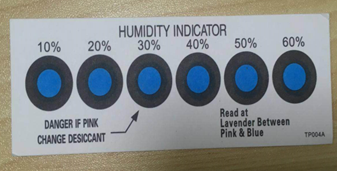
-
-
The module needs to be baked in the following cases:
- The vacuum packaging bag is damaged before unpacking.
- After unpacking, no HIC is found in the packaging bag.
- After unpacking, the HIC indicates a humidity level of 10% or higher (the circle turns pink on the HIC).
- The total exposure time has lasted for over 168 hours since unpacking.
- More than 12 months have passed since the first sealing of the bag.
-
The baking parameter settings are described below:
- Baking temperature: 40°C for reel packaging with relative humidity ≤ 5%. And 125°C for tray packaging with relative humidity ≤ 5% (use the heat-resistant tray, rather than plastic containers).
- Baking time: 168 hours for reel packaging and 12 hours for tray packaging.
- Temperature for triggering an alert: 50°C for reel packaging and 135°C for tray packaging.
- Production can begin after a module has cooled below 36°C under natural conditions.
- If a module remains unused for over 168 hours after being baked, it needs to be baked again.
- If a batch of modules is not baked after exposure for more than 168 hours, do not use reflow soldering or wave soldering to solder them. Because these modules are level-3 moisture-sensitive devices, they are very likely to get damp when exposed beyond the allowable time. In this case, if they are soldered at high temperatures, device failure or poor soldering performance might occur.
-
In the whole production process, take electrostatic discharge (ESD) protective measures.
-
To guarantee the pass rate, we recommend that you use the SPI and AOI to monitor the quality of solder paste printing and mounting.
Recommended oven temperature curve
Select a proper soldering technique according to the process. For the SMT process, refer to the recommended oven temperature curve of reflow soldering. For the wave soldering process, refer to the recommended oven temperature curve of wave soldering. The set temperatures might deviate from the actual temperature measurements. All the temperatures shown in this module datasheet are obtained through actual measurements.
Technique 1: SMT process (Recommended oven temperature curve of reflow soldering)
Set the oven temperatures according to the following curve.
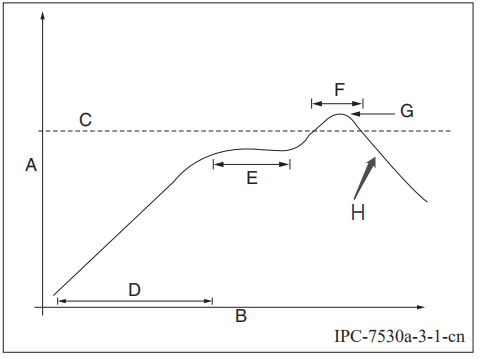
-
A: temperature axis
-
B: time axis
-
C: alloy liquidus temperature from 217°C to 220°C
-
D: ramp-up slope from 1°C/s to 3°C/s
-
E: constant temperature time from 60s to 120s, constant temperature from 150°C to 200°C
-
F: temperature above liquidus temperature for 50s to 70s
-
G: peak temperature from 235°C to 245°C
-
H: Ramp-down slope from 1°C/s to 4°C/s
The curve above is based on solder paste SAC305. For more information about other solder pastes, see the recommended oven temperature curve in the specified solder paste specifications.
Technique 2: Wave soldering process (Oven temperature curve of wave soldering)
Set the oven temperatures according to the following temperature curve of wave soldering. The peak temperature is 260°C±5°C.
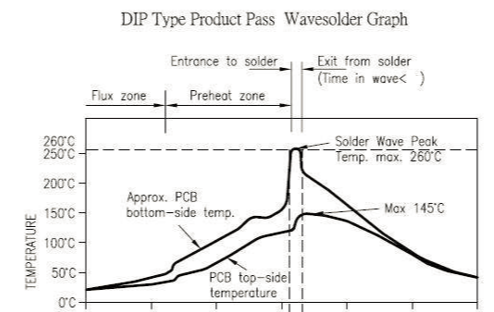
| Suggestions on wave soldering | Suggestions on manual soldering | ||
|---|---|---|---|
| Preheat temperature | 80°C to 130°C | Soldering temperature | 360°C ± 20°C |
| Preheat duration | 75s to 100s | Soldering duration | Less than 3s/point |
| Contact duration at the peak | 3s to 5s | N/A | N/A |
| Solder tank temperature | 260 ± 5°C | N/A | N/A |
| Ramp-up slope | ≤ 2°C/s | N/A | N/A |
| Ramp-down slope | ≤ 6°C/s | N/A | N/A |
Storage conditions
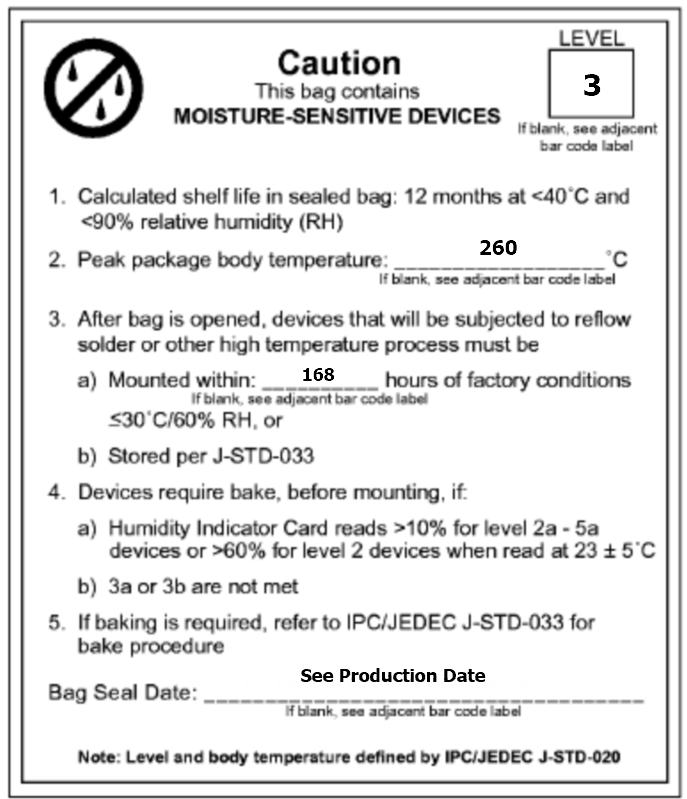
MOQ and packaging information
| Product model | MOQ (pcs) | Shipping packaging | Modules per reel (pcs) | Reels per carton |
|---|---|---|---|---|
| T1-U-IPEX | 4400 | Tape and reel | 1,100 | 4 |
Appendix: Statement
FCC Caution: Any changes or modifications not expressly approved by the party responsible for compliance could void the user’s authority to operate this device. The module is limited to installation in mobile or fixed applications.
This device complies with Part 15 of the FCC Rules. Operation is subject to the following two conditions: (1) This device may not cause harmful interference, and (2) this device must accept any interference received, including interference that may cause undesired operation.
Note: This device has been tested and found to comply with the limits for a Class B digital device, according to part 15 of the FCC Rules. These limits are designed to provide reasonable protection against harmful interference in a residential installation. This device generates, uses, and can radiate radio frequency energy and, if not installed and used following the instructions, may cause harmful interference to radio communications. However, there is no guarantee that interference will not occur in a particular installation.
If this device does cause harmful interference to radio or television reception, which can be determined by turning the device off and on, the user is encouraged to try to correct the interference by one or more of the following measures:
- Reorient or relocate the receiving antenna.
- Increase the separation between the device and receiver.
- Connect the device to an outlet on a circuit different from that to which the receiver is connected.
- Consult the dealer or an experienced radio/TV technician for help.
Radiation Exposure Statement
This device complies with FCC radiation exposure limits set forth for an uncontrolled rolled environment. This device should be installed and operated with a minimum distance of 20cm between the radiator and your body.
Important Note
This radio module must not be installed to co-locate and operate simultaneously with other radios in the host system except following FCC multi-transmitter product procedures. Additional testing and device authorization may be required to operate simultaneously with other radios.
The availability of some specific channels and/or operational frequency bands are country dependent and are firmware programmed at the factory to match the intended destination. The firmware setting is not accessible by the end-user.
The host product manufacturer is responsible for compliance with any other FCC rules that apply to the host not covered by the modular transmitter grant of certification. The final host product still requires Part 15 Subpart B compliance testing with the modular transmitter installed. The separate approval is required for all other operating configurations including portable configurations with respect to Part 2.1093 and different antenna configurations.
The end-user manual shall include all required regulatory information/warnings as shown in this manual, including “This product must be installed and operated with a minimum distance of 20 cm between the radiator and user body”. The OEM integrator is responsible for ensuring that the end-user has no manual instructions to remove or install module.
The RF module is considered as a limited modular transmitter according to FCC rules. Even though the RF module gets an FCC ID, the host product manufacturer can not use the FCC ID on the final product directly. In these circumstances, the host product manufacturer integrator will be responsible for re-evaluating the end product (including the transmitter) and obtaining the FCC authorization by a Class II permissive change application or a new application.
Declaration of Conformity European Notice

Hereby, Hangzhou Tuya Information Technology Co., Ltd declares that this module product is in compliance with essential requirements and other relevant provisions of Directive 2014/53/EU,2011/65/EU. A copy of the Declaration of conformity can be found at https://www.tuya.com.

This product must not be disposed of as normal household waste, in accordance with the EU directive for waste electrical and electronic equipment (WEEE-2012/19/EU). Instead, it should be disposed of by returning it to the point of sale, or to a municipal recycling collection point.
The device could be used with a separation distance of 20cm from the human body.
Is this page helpful?
YesFeedbackIs this page helpful?
YesFeedback





